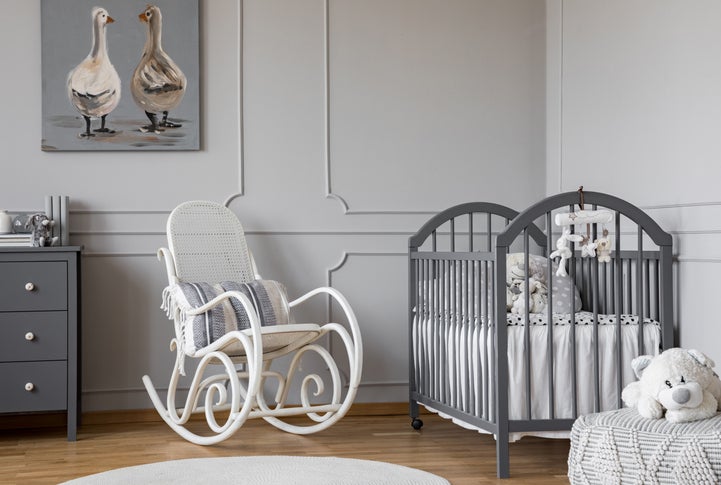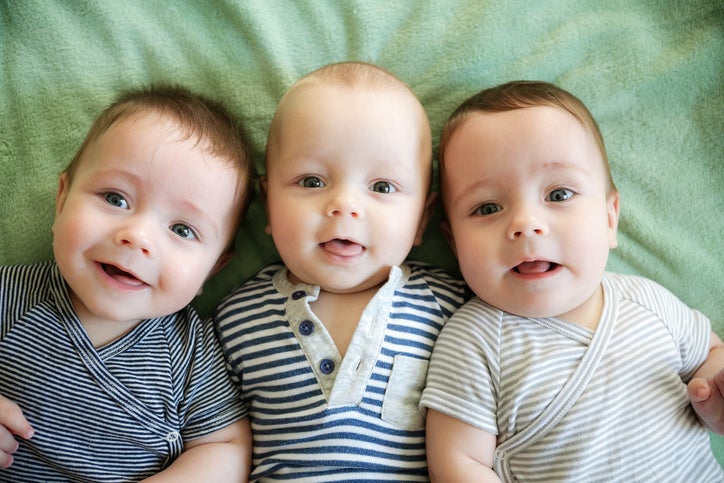-
Nursery Decor Ideas and Tips
Of all the things you must do to prepare for the arrival of a new baby, decorating the nursery may be the most fun. You get to daydream about your new little one as you design a space that’s fun and functional as well as beautiful. Here, we offer some tips for making the most of your nursery’s décor.

- Start with the crib. You may think of a crib as a temporary piece of furniture, but some kids stay in their cribs until they’re two or three years old. With cribs that convert to toddler beds and even full-size beds, you may get even more years out of it than that. Look for a crib that meets all safety standards and suits your aesthetic sensibilities, and if you plan to have more than one child, keep it gender-neutral. To go with the crib, you’ll need at least 5-6 fitted sheets, but skip the crib sets.
- Do you need a changing table? This is actually a hotly debated topic. Sure, it’s convenient to have all the storage a changing table provides, but a piece of furniture solely devoted to babyhood is likely to have an expiration date. Many parents opt for a dresser with a changing top, because when you’re out of the diaper phase, you’ll still need a dresser.
- One thing you do need is tons of storage. Arrange your nursery so that everything you need for a change of diapers or clothes is within easy reach of the changing table. This means diapers, wipes, changing table covers, burp cloths, pacifiers, toys to distract- anything you can think of needing, and extras of everything. You don’t want to have to step away from the changing table to reach something when you’re mid-change. Beyond that, you’ll need storage for all the baby stuff, so that it doesn’t end up tripping you in the middle of the night.
- Choosing a theme will help guide your décor. Find one thing that speaks to you, whether it’s a book, a painting, or some other piece of the nursery, and build your décor around it. It’s smart to keep the paint color and furniture neutral and accessorize within your theme. Don’t forget to include personal items like family photos and other elements that represent your loved ones.
- Remember that babies grow. However you decide to decorate the nursery, make sure that your décor is easy to change as your baby grows into a child. From furniture to storage to artwork, everything should grow with your little one.
If you need help with fertility in order to fill your dream nursery, Center for Vasectomy Reversal is here to help. Under the direction of Dr. Joshua Green, our team provides state-of-the-art treatment for men who need a reversal of their vasectomy or help with their fertility. To learn more, contact us through our website, or call 941-894-6428 to arrange a free consultation.
-
How to Prepare your Child to be a Big Sibling
When you’re preparing for a baby, there’s much to do and consider. When there’s already a child in your family, you may be equally nervous and excited about telling your child the news. While you may have a picture in your mind of how it will go, since you’re already a parent you probably know that children rarely respond according to our expectations. Here, we offer some tips for preparing your child for a new sibling, while also submitting the caveat that children will all respond to this life-changing news in their own way.

How you tell your child depends largely on his or her age.
- If your little one is a toddler, the concept of a new brother or sister may be hard to understand. Talk about the “new baby” excitedly, and your attitude will rub off. Be straightforward when you tell your child, and do it early on, so the news doesn’t come from someone else. Looking at picture books about babies may help, and you might consider getting a doll so that your child can have his or her own “baby” as you approach your due date.
- When the big sibling-to-be is a preschooler, delivering the news may be trickier. Children between 2-5 years of age are sensitive to change, and the idea of a new baby may feel threatening. Take your time about breaking the news, perhaps waiting until the baby bump becomes obvious or you start picking out nursery furniture. Be honest: babies are cute but also needy. Help your preschooler take ownership of the situation, letting him help you shop for baby gear or showing her pictures from her babyhood. If there will be changes to your child’s routine, try to make them before the baby arrives.
- Telling a school-aged child about a new sibling is both easier and harder. Your child will be better able to understand the concept, but may be less interested in sharing your time and attention. Involve your child in the preparation, making sure to emphasize that everyone in the family is important and has value.
No matter how you tell your child, children need to be reassured once the baby arrives. Younger children may regress, older children may feel jealous and act out. Be sensitive to your child’s feelings and needs, spending one-on-one time with your older child when possible. Let your child “help” with the baby, while making sure it doesn’t feel like a responsibility. Above all, remember that you’re building a family, practicing patience and kindness as you forge these new bonds.
At the Center for Vasectomy Reversal, we love helping people build their families. Under the direction of Dr. Joshua Green, our team provides state-of-the-art treatment for men who need a reversal of their vasectomy or have other fertility concerns. To learn more, contact us through our website, or call 941-894-6428 for a free consultation.
-
The Science of Multiple Births
Does it seem like more people than ever are giving birth to multiples? How likely are you to have twins, triplets, or even quadruplets? What raises your chance of giving birth to more than one child at once? How much do you know about the science behind multiples?

If you’ve noticed more families with multiples recently, you’re not imagining things. In the United States, about 1 in every 250 births is a multiple, a more than 75 percent increase since 1980. About 90 percent of those multiples are twins, which may be best because the risks associated with pregnancy grow with every additional child involved.
Why the steep increase in multiple births? There are many factors at play. First, the average maternal age is increasing. In 1980, the birth rate for women between ages 40 and 44 was only 3.9 births per 1000 women, but by 2003 that rate had climbed to 8.7 births per 1000 women. Women over 30 are more likely to release more than one egg during their reproductive cycles, so an older average maternal age means more multiple births.
Fertility treatments are another factor. Infertility is common in the U.S., with about 13 percent of couples pursuing treatment to help. A recent study indicated a 10-fold rise in the conception of twins following fertility treatments. The rate varies based on the type of treatment: in vitro fertilization (IVF) increases the likelihood, as does medication that stimulates a woman’s follicles, causing her to produce more eggs.
Family history plays a role, as well. If the woman has a family history of twins, she’s slightly more likely to conceive twins naturally. Women who are non-identical twins have twins in about 1 birth out of every 60. If the father is a non-identical twin, the rate is about 1 in 125 births.
Is having multiples desirable? There are many complications with births that involve multiple babies. Prematurity, low birth weight, and stillbirth are all risks of a twin pregnancy, as are disabilities at birth and congenital health conditions like autism and cerebral palsy. For the mother, the risk of preeclampsia, gestational diabetes, and cesarean section are increased when she’s carrying more than one baby, and she’s more likely to have to go on bed rest during the pregnancy. Still, having more than one child at once is very exciting, and can be a fun experience for a family.
If you’re struggling with infertility or considering a vasectomy reversal, the Center for Vasectomy Reversal is here to help. Under the direction of Dr. Joshua Green, our team provides state-of-the-art treatment for men who need a reversal of their vasectomy or have other concerns about their fertility. Whether you’re ready to schedule a procedure or just want to learn more, you can contact us through our website, or call 941-894-6428 to arrange a free consultation.
-
How to Introduce your Children to Different Cultures
With technology making the world ever smaller, in some ways we’re more connected with other cultures than ever before in history. At the same time, divisive sentiments abound, filling headlines and causing many parents to wonder how to protect their children from hateful attitudes while making them culturally empathetic. In an ideal world, we’d all be able to travel globally with our kids, but for most of us, that’s not actually our reality. Fortunately, we’ve got some tips for exposing your children to other cultures and fostering a sense of empathy and understanding.

- Use books and other media to explore the world. Books can help kids develop a sense of their own identity, and they’re also great for teaching about other countries, cultures, and religions. Read books and watch movies, television shows, and videos together, learning about people around the world, and diverse cultures here in our own nation.
- Encourage curiosity. It’s embarrassing when a child asks you something loudly about another person’s appearance or clothing in public, but it’s important to answer their questions, normalizing the fact that there are many different types of people in the world. Research other countries and cultures, and visit restaurants, cultural events, and festivals representing different ethnicities and cultural heritages. Talk about religious holidays around the world, and learn about how other cultures celebrate them.
- Find ways to spend time with different types of people. There’s a good chance that you know someone with a different heritage or religious background than yours. Talking to your kids about these differences, while giving them opportunities to become comfortable with a wide range of people, will help them become comfortable with diversity.
- Introduce your child to other languages. Sing songs that feature words in other languages, find opportunities to point out foreign words on signs and in reading materials, and let your kids watch educational programming that incorporates other languages.
- Celebrate differences and recognize commonality. As adults, we often try not to “see” differences. Little children, however, are very interested in what makes people different and what they have in common. Teach your kids to celebrate the differences while encouraging empathy by finding common ground.
- Set a good example. Your child’s best role model is you, so if you don’t feel like you know enough about different cultures, find ways to educate yourself. Making sure your reactions to people from other cultures are positive and compassionate will go along way toward fostering empathy in your children.
If you’re you want to have children but struggle with infertility, the Center for Vasectomy Reversal is here to help. Under the direction of Dr. Joshua Green, our team provides state-of-the-art treatment for men who need a reversal of their vasectomy or have other concerns about their fertility. Whether you’re ready to schedule a procedure or just want to learn more, you can contact us through our website, or call 941-894-6428 to arrange a free consultation.
Recent Posts
Popular Posts
categories
- Uncategorized
- Sperm Retrieval
- vasectomy reversal
- Emergency
- Dr. Green
- sperm count
- fertility
- male infertility
- MESA
- medical care
- low sperm count
- IVF
- male fertility testing
- anesthesia
- pregnancy
- sperm aspiration
- semen analysis
- post-vasectomy pain syndrome
- infertility
- VE
- anti-sperm antibodies
- older dad
- general anesthesia
- gender reveal party
- post-operative infections
- baby name
- parent
- baby's first year
- fertilization process
- spinal anesthesia
- ACS Fellow
- nutrition tips
- concierge-level care
- fertility planning app
- azoospermia
- out-of-town patients
- V-V
- post-vasectomy reversal
- conceiving
- vasectomy
- vasoepididymostomy
- smoking
- sperm quality
- baby registry
- infographic
- surgical care
- surgical consultation process
- prostate cancer
- baby gender
- family time
- COVID
- Baby Shower
- Child Care
- Halloween Costume Ideas for Babies
- Halloween
- Halloween Safety Tips
- Celebrity Infertility Spotlight
- Postpartum
- testosterone
- Father's Day
- Father
- Men's Health
- Thanksgiving
- Pregnancy Announcement
- Parenting Tips
- Sperm
